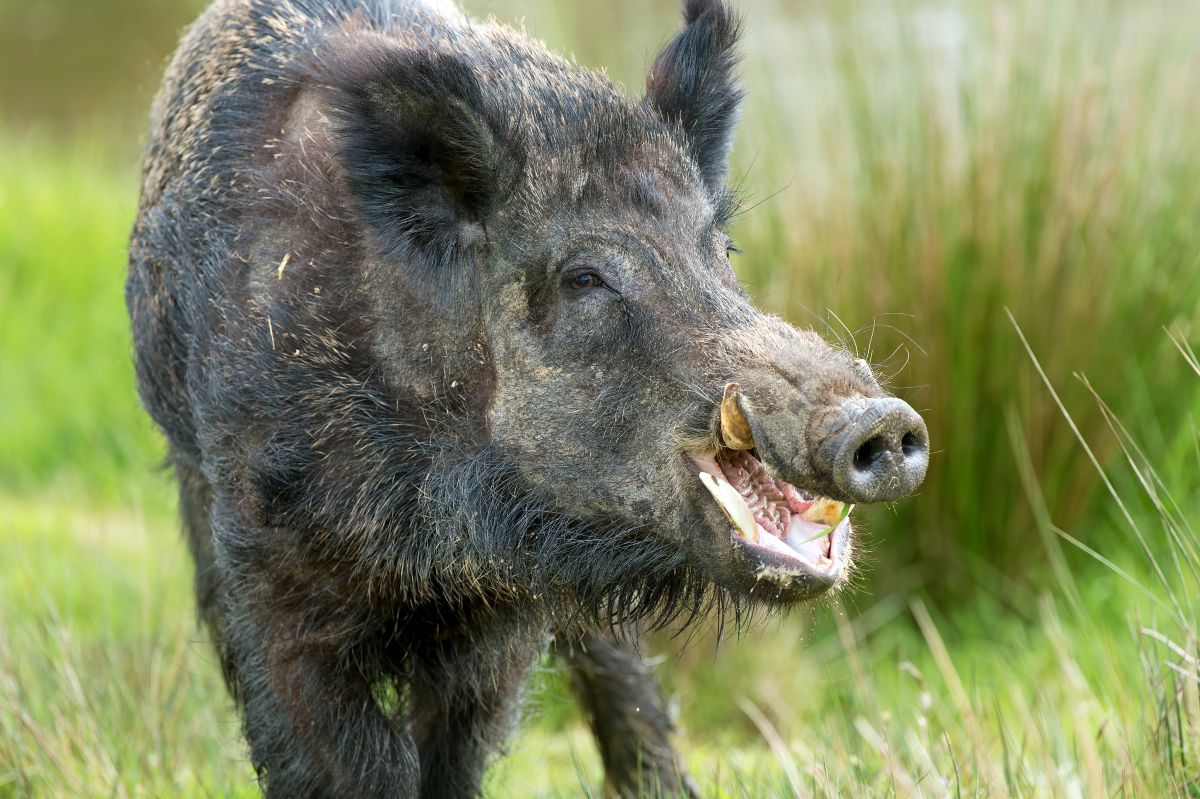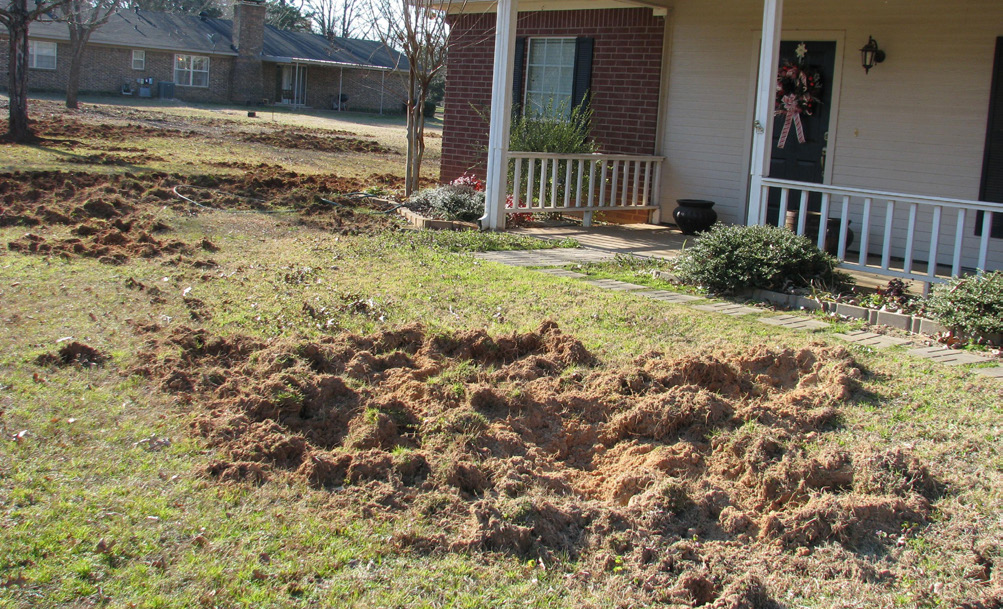Invasive Wild Pigs: Rooting toward Montana

Photo: Adobe Stock
Imagine checking the fields at sunrise only to find them cratered like the moon – ankle-deep divots, overturned sod, muddy wallows, and skittish livestock. No, aliens didn’t land. It was the arrival of feral swine, wild pig, razorback – regardless of the name, the damage is the same.
Thankfully, Montanans still wake to elk bugles and birdsong, not pig squeals. Montana remains free of wild pigs, but with established populations in the majority of the US and Canada, the threat is very real. One illegal transport or escape could quickly turn the Treasure State into hog heaven.
There’s been a concentrated effort to alert and educate Montanans to take these curly-tailed invaders seriously and to help keep wild pigs out.
What is a wild pig?
Wild pigs in the US are often categorized into three main types: feral swine, Eurasian wild boar, and hybrids. Feral swine are domestic pigs that have escaped or been released and now live in the wild. Eurasian wild boars were introduced from Eurasia and have also interbred with feral hogs. Hybrids are the result of this interbreeding. Wild pigs or feral swine are often used as a term that encompasses all varieties on the landscape.
According to the State of Montana, the legal definition of feral swine includes animals living in an untamed or wild state, as well as swine that appear to be contained for commercial hunting or trapping.
Ticking time bomb
Domestic pigs first arrived with Spanish explorers in the 1500s. Over centuries, broken fences, intentional releases for hunting, and hybridization with Eurasian wild boar created today’s feral swine: highly intelligent, adaptable, destructive, and fast-breeding. Sows can reproduce at just 6-10 months old, often producing two litters a year with an average litter size of 4-8 piglets each.
Having pigs on the landscape is like living next to a bomb with a lit fuse. Texas had only a few hundred wild pigs in the 1980s; today, it hosts over three million.
The "perfect" invasive species
Wild pigs are the jack-of-all-trades of invasive species. They thrive in deserts, forests, bayous, and even Saskatchewan’s brutal winters by building snow “pigloos.”
According to the Montana Department of Livestock, they devour almost anything and cause an estimated $2.5 billion in annual damages in the US through crop loss, fence destruction, polluted water, and disease outbreak. It’s no wonder they’re called “ecological train wrecks.”
What's at stake:
- Land and water: Wild pigs are nature’s rototillers on hooves. They root and tear up pastures, cropland, and prairies, leaving the soil bare and vulnerable to erosion and invasive weeds. Pigs churn up streams and wetlands while defecating in them, adding sediment and disease-causing bacteria that endanger livestock, wildlife, and human drinking water.
- Native wildlife: Wild pigs are garbage disposals with teeth. Although 80 percent of their diet is vegetation, pigs are opportunistic predators that will readily gobble eggs, reptiles, fawns, newborn and vulnerable livestock, or anything else they can catch.
- Agricultural threat: Wheat, barley, pulse crops, hay, and rangeland together fuel a $5 billion Montana economy. Wild pigs can quickly wipe out crops, trample rangelands, and endanger food security.
- Disease delivery: Feral swine carry more than 30 diseases and nearly 40 parasites that threaten humans, livestock, pets, and wildlife–including swine brucellosis, leptospirosis, trichinellosis, pseudorabies, and toxoplasmosis.
- Control challenges: Feral swine are Einsteins with tusks. They rank among the most intelligent non-primate mammals, comparable to dogs and dolphins on cognitive tests. Once they learn about traps or experience hunting pressure, they simply switch to strictly nocturnal habits, making control efforts exponentially harder.
- Public dollars: When wild pigs invade a new area, control efforts can be costly. Every trapped wild pig, helicopter hour, and disease test costs taxpayers. Prevention is far cheaper and more effective than long-term management.
Montana's game plan: prevention, not pig hunts
Seeing the invasive disaster unfold elsewhere, Montana took decisive action. In 2015, the state banned importing, owning, hunting, or transporting wild pigs. Violations can bring fines up to $10,000 plus the full cost of eradication.
The Montana Department of Livestock (DOL) leads eradication efforts, working with USDA Wildlife Services, Montana Fish, Wildlife & Parks, and the Montana Invasive Species Council. Public outreach is anchored by the statewide “Squeal on Pigs!” campaign. Every reported potential sighting in Montana prompts an immediate ground or aerial investigation.
To date, no wild pigs have been confirmed within Montana’s borders.
But why not allow pig hunting? While it may seem logical, states that tried recreational hunting quickly learned it made things worse. Hunting pressures the surviving pigs into new areas, teaches them to avoid humans, and creates a hunting culture and private market that resists full eradication. We can’t barbecue our way out of a feral pig invasion.
Montana took the proactive step to create strong laws that prohibit transporting or possessing feral swine. If feral swine were detected, only authorized crews using aerial surveys, trapping, and trained sharpshooters are allowed to respond. Professional removal can eliminate an entire “sounder” or group of pigs before they wise up. No hunting means no incentive to smuggle in pigs, and no half-measures that allow populations to explode.
Trouble brewing north of the border
Montana’s laws are strong, but pigs don’t read maps.
In the 1980s and 1990s, wild boar imported into Canada for game farms escaped, or were let go, and now roam vast stretches of Alberta, Saskatchewan, and Manitoba. GPS-collared boars have been tracked moving up to 40 miles a week, raising concerns they could eventually cross into Montana’s Hi-Line region.
Meanwhile, in the US, people who illegally truck pigs to “fresh” properties have helped leapfrog populations hundreds of miles. All it would take is one dumped trailer load or a few escaped pigs turned feral to ignite a biological disaster.
One pregnant sow today could mean half a dozen or more pigs in six months, and hundreds within two years. That’s biology, not hyperbole.

Photo: Billy Higginbotham, Texas AgriLife Extension Service, Bugwood.org
Know the signs
Montanans may never see a wild pig directly – sounders often move at dusk or after dark – but they leave calling cards. Signs to watch for include:
- Rooting: Freshly torn-up turf, flipped sod, and furrows, especially near wetlands, river bottoms, or croplands.
- Wallows and tree rubs: Muddy pits and tree trunks smeared with mud and hair 1-3 feet high.
- Tracks: Heart-shaped like deer, but rounder and wider, about 2-3 inches long.
- Scat: Generally varies more in color and texture than other mammals due to their range in diet. Oftentimes clumpy, measuring 3-9 inches, and is either tan or black in color.
Keep The Last Best Place pig-free
Wild pigs are a slow-motion tornado – once they touch down, they’re almost impossible to stop. Montana has a rare gift: a clean slate. We can still learn from others’ mistakes, and it requires every Montanan to stay vigilant and report any sighting as quickly as possible.
The best way to keep Montana’s farms, wildlife, and waterways safe is simple: prevention. If you hike, hunt, farm, or fish – keep an eye on the ground. If the soil looks freshly rototilled or you see strange tracks, grab a phone, snap a photo, and squeal on pigs.
Let’s keep Montana the Last Best Place without pigs gone wild.
IF YOU SEE OR SUSPECT WILD PIGS:
|
Jared Beaver is the MSU Extension Animal and Range Sciences Specialist.
